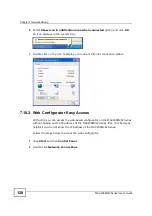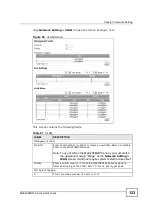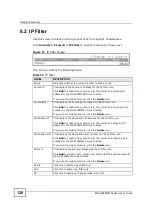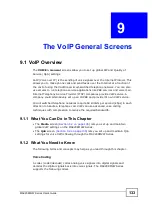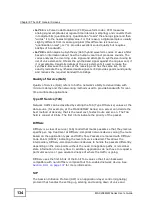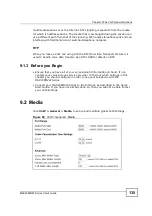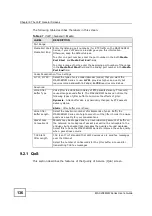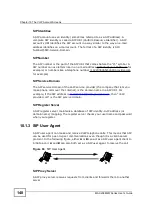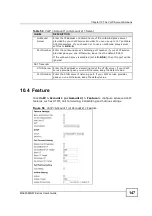
Chapter 9 The VoIP General Screens
MAX208M2W Series User
s Guide
134
G.711
is a Pulse Code Modulation (PCM) waveform codec. PCM measures
analog signal amplitudes at regular time intervals (sampling) and converts them
into digital bits (quantization). Quantization
reads
the analog signal and then
writes
it to the nearest digital value. For this reason, a digital sample is usually
slightly different from its analog original (this difference is known as
quantization noise
). G.711 provides excellent sound quality but requires
64kbps of bandwidth.
G.729
is an Analysis-by-Synthesis (AbS) hybrid waveform codec. It uses a filter
based on information about how the human vocal tract produces sounds. The
codec analyzes the incoming voice signal and attempts to synthesize it using its
list of voice elements. It tests the synthesized signal against the original and, if
it is acceptable, transmits details of the voice elements it used to make the
synthesis. Because the codec at the receiving end has the same list, it can
exactly recreate the synthesized audio signal.G.729 provides good sound quality
and reduces the required bandwidth to 8kbps.
Quality of Service (QoS)
Quality of Service (QoS) refers to both a network's ability to deliver data with
minimum delay and the networking methods used to provide bandwidth for real-
time multimedia applications.
Type Of Service (ToS)
Network traffic can be classified by setting the ToS (Type Of Service) values at the
data source (for example, at the MAX208M2W Series) so a server can decide the
best method of delivery, that is the least cost, fastest route and so on. The ToS
field is consist of 8 bits. The first 3 bits indicate the priority of the packet.
DiffServ
DiffServ is a class of service (CoS) model that marks packets so that they receive
specific per-hop treatment at DiffServ-compliant network devices along the route
based on the application types and traffic flow. Packets are marked with DiffServ
Code Points (DSCPs) indicating the level of service desired. This allows the
intermediary DiffServ-compliant network devices to handle the packets differently
depending on the code points without the need to negotiate paths or remember
state information for every flow. In addition, applications do not have to request a
particular service or give advanced notice of where the traffic is going.
DiffServ uses the first 6 bits of the 8-bit ToS value so that it can backward
compatible with non-DiffServ compliant but ToS-enabled network device. See
Section 9.3.1 on page 137
for more information.
SIP
The Session Initiation Protocol (SIP) is an application-layer control (signaling)
protocol that handles the setting up, altering and tearing down of voice and
Summary of Contents for MAX208M2W SERIES
Page 2: ......
Page 10: ...Contents Overview MAX208M2W Series User s Guide 10 ...
Page 16: ...Table of Contents MAX208M2W Series User s Guide 16 Index 299 ...
Page 17: ...17 PART I User s Guide ...
Page 18: ...18 ...
Page 24: ...Chapter 1 Getting Started MAX208M2W Series User s Guide 24 ...
Page 42: ...Chapter 3 Setup Wizard MAX208M2W Series User s Guide 42 ...
Page 62: ...Chapter 4 Tutorials MAX208M2W Series User s Guide 62 ...
Page 63: ...63 PART II Technical Reference ...
Page 64: ...64 ...
Page 132: ...Chapter 8 Security MAX208M2W Series User s Guide 132 ...
Page 156: ...Chapter 10 The VoIP Account Screens MAX208M2W Series User s Guide 156 ...

